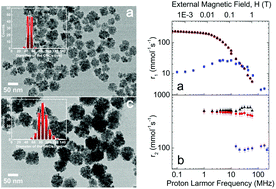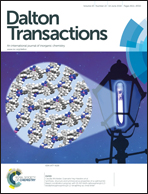Colloidal assemblies of oriented maghemite nanocrystals and their NMR relaxometric properties†
Abstract
An elevated-temperature polyol-based colloidal-chemistry approach allows for the development of size-tunable (50 and 86 nm) assemblies of maghemite iso-oriented nanocrystals, with enhanced magnetization. 1H-nuclear magnetic resonance (NMR) relaxometric experiments show that the ferrimagnetic cluster-like colloidal entities exhibit a remarkable enhancement (4–5 times) in transverse relaxivity when compared to that of the superparamagnetic contrast agent Endorem®, over an extended frequency range (1–60 MHz). The marked increase in the transverse relaxivity r2 at a clinical magnetic field strength (∼1.41 T), which is 405.1 and 508.3 mM−1 s−1 for small and large assemblies, respectively, makes it possible to relate the observed response to the raised intra-aggregate magnetic material volume fraction. Furthermore, cell tests with a murine fibroblast culture medium confirmed cell viability in the presence of the clusters. We discuss the NMR dispersion profiles on the basis of relaxivity models to highlight the magneto-structural characteristics of the materials for improved T2-weighted magnetic resonance images.


 Please wait while we load your content...
Please wait while we load your content...